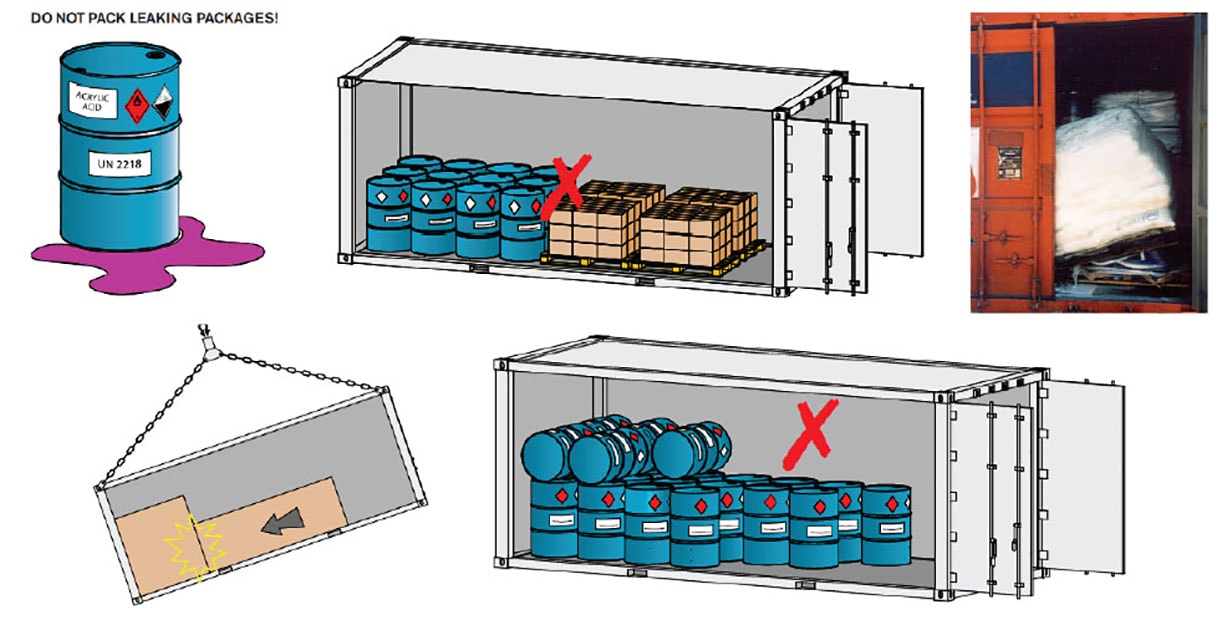Supporting your supply chain is of the utmost importance to us, hence we would like to highlight some of the important aspects when packaging dangerous goods for transport.
The code of practice for packing of cargo transport units (CTU code) has been adopted as non-mandatory international law and is a reference from the IMDG code. Poor packing practices and improperly secured load give rise to many incidents along the international supply chain, resulting in damage, loss and injuries on land and sea.
Key shipping requirements for safe packaging’s of dangerous goods.
- Strong enough to withstand the shocks and loading to transport and all types of handling
- Designed to prevent loss of content owing to variations in pressure, temperature, or humidity
- Not be weakened by contact with the product
- Not react with the product to cause a dangerous reaction, or affect the quality of the product
Unless exempted by provision with the IMDG Code (Chapter 3.4.2), for example limited quantities, all packaging’s used for dangerous goods shall have successfully met the UN package test standards described in IMDG code part 6, construction and testing of packaging’s’. Packaging’s that have met these standards are conventionally referred to as ‘UN tested’ or ‘UN approved’ packaging’s.
Here are the DO’S
- At all times Only load packages that are in sound conditions without damage and leak into a cargo transport unit (CTU).
- When packing a CTU with a mixture of dangerous goods and non-DG, always place the dangerous goods close to the door, with the labels also facing the door.
- Pack solids over liquids. In general liquids are often heavier than solids, so it makes sense to pack with weight down, provided the drums are strong and can bear the weight. The main reason is to ensure safety. If the drums leak, there will be a release of liquid that will first be drawn downwards by the force of gravity. Always stow light goods over the heavy goods.
- The weight spread should be evenly distributed in the container.
- When shipping drums/jerricans place a solid plywood between the layers of drums to prevent sliding motion.

Here are the DON’T’s
- Never pack damaged and leaking packages into a cargo transport unit (CTU).
- When packing a CTU with a mixture of dangerous goods and non-DG, do not place the dangerous goods away from the door.
- Do not pack liquids over solids. In general liquids are often heavier than solids, so it makes sense to pack with weight down, provided the drums are strong and can bear the weight. The main reason is to ensure safety. If the drums leak, there will be a release of liquid that will first be drawn downwards by the force of gravity. Do not stow heavy goods on top of light goods.
- Weight at one end can cause container to be unbalanced during load/unloading operation.
- It is forbidden to stow drums/jerrycans containing dangerous goods ‘on the roll’. Drums have closures at the top which are not designed to be below the liquid level.

General Recommendations
- Never use sawdust or any other combustible material to absorb moisture in case of a leakage. Sawdust reacts with many solid and liquid dangerous goods and the reaction can lead into an explosion.
- Any void space more than 15 cm in total (side to side) must be filled with dunnage like air bags, foam, timber, etc.
Reference:
See CTU code 2.3.6 - Include dangerous goods placarding and labelling
References:
IMDG code chapter 5.2 (Marking and labelling of packages including Intermediate Bulk Container IBC)
IMDG code chapter 5.3 (Placarding and marking of cargo transport units and bulk containers)
For further information, you can refer to below links:
Please do not hesitate to reach out to your local Maersk representative should you have any questions.
Anything you need, we’re here to help
I agree to receive logistics related news and marketing updates by email, phone, messaging services (e.g. WhatsApp) and other digital platforms, including but not limited to social media (e.g., LinkedIn) from A. P. Moller-Maersk and its affiliated companies (see latest company overview). I understand that I can opt out of such Maersk communications at any time by clicking the unsubscribe link. To see how we use your personal data, please read our Privacy Notification.
By completing this form, you confirm that you agree to the use of your personal data by Maersk as described in our Privacy Notification.